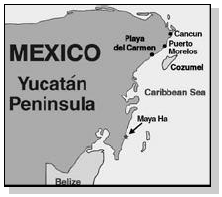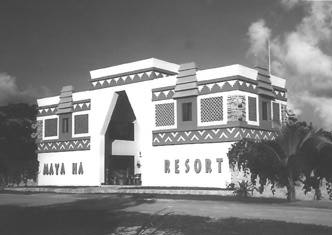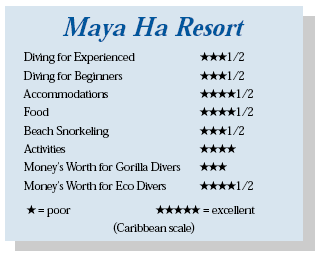Maya Ha, Yucatan PeninsulaContents of this Issue: DACOR survives -- and offers big bucks off a Viper regulator until August 31 Shark Feeding Debate Continues in Florida When Your Ship Leaves Without You Editorial Office: Ben Davison Publisher and Editor Undercurrent 3020 Bridgeway, Suite 102 Sausalito, CA 94965 A remote outpost for eco-divers from the July, 2001 issue of Undercurrent
Dear Fellow Diver, Seventeen miles off Mexico’s Yucatan Coast, about halfway between Cozumel and the northern reefs of Belize, lie the Chinchorro Banks, an atoll six miles by thirty. With little population and virtually no tourist development on the coast, Chinchorro has seldom been dived. So, it carries an aura of virgin reefs, wrecks and unexplored territory. A couple of years ago Maya Ha Resort opened, with an eye toward diving Chinchorro. Reviewing Maya Ha Resort is a test of Undercurrent’s objectivity. You see, it’s owned by John Shobe, who as John Q. Trigger edited Undercurrent for several years, after founding In Depth (a newsletter which we folded into Undercurrent). Last December, when I learned he would be at home in Austin, Texas, I visited Maya Ha, making reservations under a friend’s name and charging in advance on his credit card. Maya Ha is a great place. But I lost a day because of the trots (picked up elsewhere) and two more days because both dive boats were broken down. I didn’t see enough underwater to write about, but what I saw was pretty, yet ordinary. I did learn that while the diving may be virgin, the banks have been fished forever, as has nearly all of the Caribbean. Fishermen live in stilt houses near small islands. How many, I’m unsure. However, I saw nearly 150 join a colorful Christmas religious flotilla. To get a review, one of our anonymous Undercurrent correspondents, who’s kicked across more Caribbean reefs than he can remember, traveled to Maya Ha in late March. He filed this report. --Ben Davison Inside, a spectacular white stucco four-story Mayan-style pyramid housed the restaurant and bar. The Mayan theme didn’t carry to the beachfront cabanas, which were identical comfortable duplexes with porches facing the ocean. (The ocean view was blocked by thriving sea grape trees -- they’ll save the beach come hurricane season.) My spotless and comfortable unit contained -- as they all do -- two firm double beds, a private bath with a roomy tiled shower, plenty of shelf space, and potable tap water, thanks to a reverse-osmosis purified water system. Outside our window several chachalakas (kinda like a Mayan wild turkey that makes sounds like its name) inhabited a tropical berry tree, which brilliant mango orioles occasionally visited. Once, even a toucan appeared. So, I had a great landbased nature tour. But, would nature underwater measure up? Getting to Chinchorro Banks is no
slam dunk. In the winter, winds can make
the crossing impossible. [Note from Ben:
When I visited in December, some guests
had missed several days of diving.] They
make it about 75 percent of the time,
but some days the wind kicks up schmutz
from the reef, reducing visibility. When they can’t make the crossing, they dive
reefs off the hotel. My Chinchorro dives varied from shallow ho-hum, low-visibility, “when-isthis- dive-going-to-end?” kinds of dives, to some gin-clear drifts on a pristine coral reef accompanied by schools of iridescent blue tangs, adult midnight parrots (the largest almost three feet with a bumphead silhouette) and turtles. A couple I’d rank among my best of the Caribbean. One day the boat had engine trouble, so we did an exploratory dive where we were. I was enjoying the swim, when suddenly Adolpho, our guide, furiously flapped his arms. I looked out to see a beautiful ray winging along. Then, 18 more came gliding by. As I hovered in awe, the lead ray slowly turned and swam toward me. He seemed to look me over, then banked like a hang glider to lead his squadron again. Soon, the cruisers made an encore and I felt like a teenager in love. If you want to try your luck here, ask for “Bad Engine Oil Reef,” the name Adolpho christened it with. I had one lousy dive. We wanted to see a wreck so Adolpho set out to show us the tip of a large old copper ship. We swam against a strong current, some divers pulling themselves along the 60-foot sandy bottom with their dive knives. Once at the site, I thought, “What, this? For a couple strips of metal debris?” We continued against an even stronger current to a coral head. As we started back, the current had changed and I was swimming back into it. I even saw a small waterspout spinning in the sand. When we surfaced, Adolpho “jokingly” told us that we passed the test. Having sucked my tank to the bone, it occurred to me that I hadn’t come here to pass tests. Typically, however, I dropped to 60 feet where the mini-wall started, drifted along at 60 to 90 feet for about 40 minutes, then eventually surfaced and signaled the boat to come get me (once a diver got separated from the group during bad visibility and a strong current, and it took nearly an hour to retrieve him). Visibility ran anywhere from 25 to 90 feet (and the water 78-80o). The mini-wall gently sloped down to about 110 feet, with cuts and overhangs. You could fit your dive gear in the large barrel sponges. Beautiful orange elephant ear sponges were bigger than real elephant ears and there was plenty of black coral, mounds of star and brain coral, and healthy deep maroon and purple sea fans. I saw pristine honeycombed plate coral and ivory tree coral at one spot. Yellow and purple sponges were longer than my arm. And watch out for the blade fire coral. One of the three daily dives would be in 20 to 50 feet of sandy patch, with coral heads mixed with mustard hill mounds, boulder star and brain coral, and often healthy elkhorn coral and stag horn coral in deeper waters. Fish? Sure I saw great barracuda, schools of southern sennets, giant puffer fish, morays, stingrays, nurse sharks, angels, spotted drums and plenty of others. But, just like the rest of the Caribbean -- and before long, the rest of the world -- fish that have market value, conch included, are farmed and loaded on the boats from the mainland that periodically come to collect them. It’s not a very fishy place. But, there were millions of thimble jellies. Their sting was mild, but when surfacing through a swarm, they can ruin your afternoon. One diver without a wetsuit, was stung repeatedly and was not a happy camper. Between dives one day, we visited a small key where eleven small wooden stilt houses harbor local fisherman. We piled into one shanty for a prearranged lunch of barracuda and tacos, pickled onions and peppers. A saltwater crocodile popped his head up when he heard the ruckus, then swam over for scraps. (Watcho, the schmoozer diveguide told me that thousands of salt water crocodiles once roamed these waters, but have succumbed to “fishermen,” who shoot them for meat and skins.) Don Higbie, who spent several
years at Cayos Cochinos in Honduras,
runs the dive operation. The crew of
local dive masters served us well.
They don’t volunteer to help with
gear, but just ask if you want help.
The 48-foot Pro 48 jet drive Kai - Ha (the other boat is a Pro 42 jet
drive) is a beautiful 1320 hp twinengine
equipped with GPS. It can hold
60 tanks comfortably for 20 divers.
The boat is equipped with a sun
deck, shade area, camera table, rinse tank and a working head. The boat lunch included Dagwood sandwiches, potato salad, hot peppers, ice-cold mangoes, lots of cookies, and cold juice or water. During dive intervals there was plenty of time for snorkeling, where in the shallows I saw frisbee-sized starfish, barracuda, stingrays and psychedelic reef fish. (The guides engaged in a little spearfishing.) After a third dive, we headed back to the hotel and arrived around 4:30 p.m. [Note from Ben: In the winter they may rush the third dive or cut it short so that the boat can get back before the early sunset.] After sunset, divers gathered in the upstairs bar and pool table room over a cold cerveza or a fresh and potent margarita made by Daniel, the chef, bartender and resident shaman. Unlike most dive resort bars, this isn’t a particularly appealing room, with barren white walls, small windows, and no deck off the bar. But the air conditioning is welcome. When dinner is announced, guests amble downstairs, usually joining others at one big table. Daniel and his kitchen staff prepared delicious meals with a different native flair nightly. He uses whatever is fresh to invent dishes from the ingredients at hand. The meal started with either a fresh salad with homemade dressing or a delicious soup, usually a light cream of veggie of-the-day with exotic spices to intrigue your taste buds. The main course was fresh kingfish, sea bass, or dolphin, grilled to a moist and tender texture with a light sauce, ranging from a mango salsa to a veggie chili. Grilled local lobster was a real treat. It was topped off with superb desserts ranging from fresh flan to mango shortcake. Not your average dive resort meals, definitely a cut above. (Amazingly, the service was actually too fast. When I put my fork down there was someone from the staff asking if I was finished.) They can also satisfy special requirements, such as a delicious peanut stirfry and pasta primavera for vegetarians. The breakfasts consisted of fresh pineapple, watermelon, cantaloupe, then fantastic French toast, scrambled eggs, fresh squeezed juices, coffee or tea, or a full Mayan breakfast at the buffet. The staff ate at adjacent tables, coming and going at will. In fact, one nice feature of Maya Ha is a genuine family feeling, with friendly kids about, different people helping everywhere, even Todd, the manager, clearing tables. Pony-tailed Daniel, whose father was from Spain, is a special guy. One night the sound of ancient drums drew us to the pyramid’s observation deck, where he was saluting the jungle sunset on his congo drums. Another time he prepared a full Mayan sweat lodge ceremony, heating ceremonial rocks till they glowed red. With a pitchfork, he carried them into the sweat lodge and dropped them into the center pit. Then, he invited us in, and began the two-hour ancient sacred Mayan ceremony. Steam filled the air as the water was splashed on the hot rocks. Herbal potions splashed over our bodies and chanting and dancing prepared us for the next adventure dive. The magic continued when we finished and headed to the dining room for a late dinner. Todd came into the dining room, his face full of surprise. He had just seen two adult Jaguars run across the road, he said, and by the size of his eyes, he was spinning no shaman’s tall tale. There’s even more adventure here. One day, after a 45-minute drive, we kayaked a mile to Ibis Island, a bird sanctuary in the Bay of Chetumal. I saw thousands of birds, including frigates, pelicans, sensational roseate spoonbills, and young ibis in their nests. [Ben’s note: I toured the small ruins at Kohunlich, where few tourists roam. With much of the area still covered by jungle, these nearly deserted ruins appear more mystical than larger, well-known ruins in the Yucatan. On the way back, we had an excellent lunch at Cenote Azul, then made a dive down to 150 feet in the fresh water cenote where a few small fish swam in green, murky water. Nothing special, but it gives one an opportunity to brag about being a cenote diver.] Some people who come to dive three-a-day every day, will be disappointed in the absence of big fish, wrecks to penetrate, and walls to cruise. I think the Belize outer islands have a notch better diving. But, folks, this is the only true “divers eco-resort” in the Caribbean. Dominica has great hikes. You can split three days diving and spend three days in the jungle in Belize. But, Maya Ha sits among nature. It’s a fine venue for people who want variety (see sidebar). However, I’ll be damned if they’re not building a cruise terminal in the middle of nowhere a few miles away and expect to transport guests to Maya Ha to dive. You’ve still got a while to enjoy the area. But see it soon. Remember what Joni Mitchell wrote and sang: “They paved paradise and put up a parking lot.” --Sid Hartha |

I want to get all the stories! Tell me how I can become an Undercurrent Online Member and get online access to all the articles of Undercurrent as well as thousands of first hand reports on dive operations world-wide
| Home | Online Members Area | My Account |
Login
|
Join
|
| Travel Index |
Dive Resort & Liveaboard Reviews
|
Featured Reports
|
Recent
Issues
|
Back Issues
|
|
Dive Gear
Index
|
Health/Safety Index
|
Environment & Misc.
Index
|
Seasonal Planner
|
Blogs
|
Free Articles
|
Book Picks
|
News
|
|
Special Offers
|
RSS
|
FAQ
|
About Us
|
Contact Us
|
Links
|
3020 Bridgeway, Ste 102, Sausalito, Ca 94965
All rights reserved.

 Nestled on a 60-mile strip of undeveloped
coast lies the small -- 18 duplex units -- and
modern resort of Maya Ha. A four-hour drive from
Cancun -- it’s not yet served by air -- the very
isolation attracted me. Pepe, the knowledgeable
and friendly driver who picked us up at the
Cancun Airport, made the journey seem like a
Sunday drive. The first half was on a double-lane
highway, with small towns along the way. The
adventure began the last 75 miles, when the road
narrowed and we were waved through the first of
two military check points. Along the way we passed
through a few butterflies, then hundreds, then
thousands, then millions! Wow, we were in the middle
of a Pipevine swallowtail butterfly migration. We turned east through the Sian
Ka’an Biosphere Reserve, where giant Jabiru storks stood tall in mangrove swamps,
birds of prey dived for tesquintles (a bushy-tailed rodent), and a grey fox, a
coati-mundi, and even a small deer scampered across the road. At the last military
checkpoint, we stepped out of the car so
Federales, looking for drugs and guns,
could conduct an unthreatening search
through our luggage. Then onward to a
severely pocked sand road leading
through the jungle to Maya Ha -- and its
high-arched brightly colored entrance.
Nestled on a 60-mile strip of undeveloped
coast lies the small -- 18 duplex units -- and
modern resort of Maya Ha. A four-hour drive from
Cancun -- it’s not yet served by air -- the very
isolation attracted me. Pepe, the knowledgeable
and friendly driver who picked us up at the
Cancun Airport, made the journey seem like a
Sunday drive. The first half was on a double-lane
highway, with small towns along the way. The
adventure began the last 75 miles, when the road
narrowed and we were waved through the first of
two military check points. Along the way we passed
through a few butterflies, then hundreds, then
thousands, then millions! Wow, we were in the middle
of a Pipevine swallowtail butterfly migration. We turned east through the Sian
Ka’an Biosphere Reserve, where giant Jabiru storks stood tall in mangrove swamps,
birds of prey dived for tesquintles (a bushy-tailed rodent), and a grey fox, a
coati-mundi, and even a small deer scampered across the road. At the last military
checkpoint, we stepped out of the car so
Federales, looking for drugs and guns,
could conduct an unthreatening search
through our luggage. Then onward to a
severely pocked sand road leading
through the jungle to Maya Ha -- and its
high-arched brightly colored entrance. Since I dove
Chinchorro daily, I can only report what
two Wyoming divers who dived the coast
said: The visibility was better than
Chinchorro and they saw more fish. They
even swam with some dolphins while diving.
Since I dove
Chinchorro daily, I can only report what
two Wyoming divers who dived the coast
said: The visibility was better than
Chinchorro and they saw more fish. They
even swam with some dolphins while diving. On a good day,
the closest part of the reef is an
hour, but in rough seas more distant
points can take up to two-and-a-half
hours of real rock ‘n’ roll.
On a good day,
the closest part of the reef is an
hour, but in rough seas more distant
points can take up to two-and-a-half
hours of real rock ‘n’ roll. Diver’s Compass: The best time to dive Chinchorro is June, July,
and August, when seas are flat and the waters are calm and clear.
September and October can be excellent -- as long as there’s not a
hurricane. In the winter, it’s subject to the same northers that
blow into Cozumel, Belize and the rest of the Caribbean, and
because of the long journey to the Banks, you may not get there
for 2-3 days at a time ... You can contact the Maya Ha Resort
through Karen Farley, U.S. Office, 2206 Forest Bend, Austin, Texas 78704 or call
877-443-1600 or 512-443-2977; fax 512-443-2977. E-mail:
Diver’s Compass: The best time to dive Chinchorro is June, July,
and August, when seas are flat and the waters are calm and clear.
September and October can be excellent -- as long as there’s not a
hurricane. In the winter, it’s subject to the same northers that
blow into Cozumel, Belize and the rest of the Caribbean, and
because of the long journey to the Banks, you may not get there
for 2-3 days at a time ... You can contact the Maya Ha Resort
through Karen Farley, U.S. Office, 2206 Forest Bend, Austin, Texas 78704 or call
877-443-1600 or 512-443-2977; fax 512-443-2977. E-mail: 